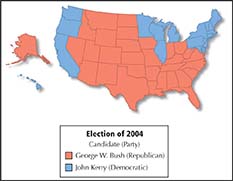American Issues  Connector: Sectionalism and National Politics
Connector: Sectionalism and National Politics

The presidential election of 2004
TRACK THE ISSUE
![]() How do regional differences affect national politics?
How do regional differences affect national politics?
Throughout U.S. history, people in different parts of the country have had different views on important national issues. These differences have sometimes divided American politics along regional lines. Use the timeline below to explore this enduring issue.
-
1787 Three-fifths Compromise
North and South disagree over how to count enslaved people for congressional representation.
-
1812 War of 1812
Western and southern farmers favor war.
-
1816–1832 Tariffs
North wants protective tariffs.
-
1861 Civil War
Disagreements between the North and the South lead to the Civil War.
-
1948 Dixiecrats
Southern Democrats split from their party over civil rights.
-
2004 Presidential Election
Election confirms division between Democratic and Republican states.

Henry Clay, a senator from the western state of Kentucky, supported the War of 1812.
DEBATE THE ISSUE
Red and Blue States Recent presidential elections have revealed an alleged political divide between the states. “Red” states in the South, West, and Midwest have generally voted Republican. “Blue” states in the Northeast and Pacific West have generally voted Democratic. Are regional or sectional differences affecting voting patterns?
“Democrats and Republicans once came from the same kinds of communities. Now they don’t…. The nation has gone through a big … sifting of people and politics into what is becoming two Americas. One is urban and Democratic, the other Republican, suburban and rural.”
—Bill Bishop, Austin American-Statesman
“Very little in politics, very little in life is black and white, or in this case, red and blue. There’s an awful lot of gray…. Truth be told, if we ask about core American values and core beliefs, about opportunity, equity and how we should go about living our lives, we see very little [if] any difference.”
—Samuel Abrams, Harvard University researcher
 TRANSFER Activities
TRANSFER Activities
- Compare In what way does Bishop believe the United States is split? How does Abrams see the red-blue divide?
- Analyze How do you think each of the writers quoted above would respond to the regional differences of opinion regarding the War of 1812?
- Transfer Use the following Web site to see a video, try a WebQuest, and write in your journal. Web Code: neh-6702




